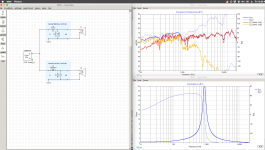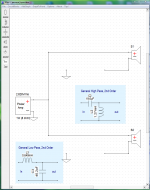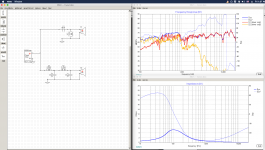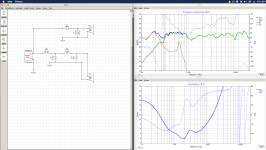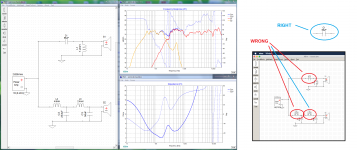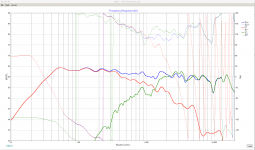zedda,
YOu can use that mic with a PC! 🙂 That's the poing. 🙂 You can use the $12 mic with Room EQ Wizard or soemthing without needing a separate preamp.
Best,
Erik
Is that mic reasonably accurate? Its a bargain if it is
There's something I don't get completely...
I made my frd and zma files that I added to the driver.
I get the frequency response as is.
When I add any kind of filter, I see the changes on the impedance graph, but the frequency response graph never changes. It always stay to the initial rendering...
Is there something else? I thought I could see the impact of adding lowpass / highpass filters on the frequency graph...
I made my frd and zma files that I added to the driver.
I get the frequency response as is.
When I add any kind of filter, I see the changes on the impedance graph, but the frequency response graph never changes. It always stay to the initial rendering...
Is there something else? I thought I could see the impact of adding lowpass / highpass filters on the frequency graph...
Perceval,
Some component schematics only does change impedance and that logic can be handy application sometimes : ) but to analyze further can you hang on a zip'ed dot-DXO file or show picture of situation.
Some component schematics only does change impedance and that logic can be handy application sometimes : ) but to analyze further can you hang on a zip'ed dot-DXO file or show picture of situation.
Do you see the summed response of different drivers? Have you turned on the right chart and curves?
as frangus mentioned... for a 2-way make sure you added a Woofer FRD&ZMA and a Tweeter FRD&ZMA (a total of 4 files input). Then you should be able to use check boxes on the graph output to show Woofer, Tweeter and summed response curves.
Then as you add a XO circuit (***making sure you have a positive and ground complete circuit) you should see the individual and summed responses change.
Then as you add a XO circuit (***making sure you have a positive and ground complete circuit) you should see the individual and summed responses change.
Thanks all...
My system just crashed and I didn't save anything... redoing all at this moment.
I see the summed response of the 2 drivers used (called system).
I have all 4 files loaded into the 2 drivers.
I haven't seen any checkboxes though. I saw that I can add driver 1 and 2, system response (I believe that's the summed one)
Ok, I've made a dummy run at it... added a lowpass and a highpass but still doesn't show.
Here's the picture... and the dxo file (zipped).
it's not the actual file I was trying to work on, but it should have showed some frequency changes as I added 2nd order at 1k for both high and low pass filters.
My system just crashed and I didn't save anything... redoing all at this moment.
I see the summed response of the 2 drivers used (called system).
I have all 4 files loaded into the 2 drivers.
I haven't seen any checkboxes though. I saw that I can add driver 1 and 2, system response (I believe that's the summed one)
Ok, I've made a dummy run at it... added a lowpass and a highpass but still doesn't show.
Here's the picture... and the dxo file (zipped).
it's not the actual file I was trying to work on, but it should have showed some frequency changes as I added 2nd order at 1k for both high and low pass filters.
Attachments
Last edited:
Top right-hand box, click on Graphs and you can choose "drivers" to display. Look like you found that.
What drivers are you using? woofer and full-range it appears?
Driver 1 - should be your tweeter based on XO you have input. Change to a 10uF series cap and a 0.30mH coil shunt to ground and you will need an L-pad to attenuate. A series and parallel resistor after the coil (series will be low maybe 2-3 ohms, parallel will be fairly high try 15-20 ohms to start).
Usually you would cross the woofer at ~2,000Hz (start with a 2.0mH series coil and a 10uF cap to ground) and the parts I mentioned above on the tweeter and see if that will get you started.
What drivers are you using? woofer and full-range it appears?
Driver 1 - should be your tweeter based on XO you have input. Change to a 10uF series cap and a 0.30mH coil shunt to ground and you will need an L-pad to attenuate. A series and parallel resistor after the coil (series will be low maybe 2-3 ohms, parallel will be fairly high try 15-20 ohms to start).
Usually you would cross the woofer at ~2,000Hz (start with a 2.0mH series coil and a 10uF cap to ground) and the parts I mentioned above on the tweeter and see if that will get you started.
At first look at that picture is that zma file show low impendance close to zero ohm, will have a look into dxo file also.
EDIT found error, see below when we lift HP and LP section away you have strait wire underneat direct to drivers, so delete those and lift HP/LP filters back and make new multiple shorter wires between terminal points.
EDIT found error, see below when we lift HP and LP section away you have strait wire underneat direct to drivers, so delete those and lift HP/LP filters back and make new multiple shorter wires between terminal points.
Attachments
Last edited:
What I posted was just a quick add on of 2nd order high and lowpass... not the filters I had in place at the time.
The drivers are a full range and a Subwoofer in a FAST setup. XO will be at 250Hz.
I redid my original XO... Here what it looks like.. it didn't change from the other picture, even though the values are totally different.
The drivers are a full range and a Subwoofer in a FAST setup. XO will be at 250Hz.
I redid my original XO... Here what it looks like.. it didn't change from the other picture, even though the values are totally different.
Attachments
C1 has a wire through it. 🙂
Your clue should be your impedance chart. A normal 2 way has 2 bumps, a ported 3.
Best,
Erik
Your clue should be your impedance chart. A normal 2 way has 2 bumps, a ported 3.
Best,
Erik
Ha!
BYRTT, you had it.... and just about everybody else but me!
I initially thought I could just drop HP/LP/inductors/capacitors onto a line and it would lock in and add itself to the line.
Now, I see, I have to stop the conductive line between components.
Sorry to be so obtuse.... now I get it....
You know, we sometimes get stuck with little things...
Thanks a bunch! now, I got it going.
Thanks for providing the program.... love how it "clicks" all together.
BYRTT, you had it.... and just about everybody else but me!
I initially thought I could just drop HP/LP/inductors/capacitors onto a line and it would lock in and add itself to the line.
Now, I see, I have to stop the conductive line between components.
Sorry to be so obtuse.... now I get it....
You know, we sometimes get stuck with little things...
Thanks a bunch! now, I got it going.
Thanks for providing the program.... love how it "clicks" all together.
Attachments
: ) perceval, same mistake you place components or circuits upon wires, don't do that place components/circuits and then wire between terminal points. Look below where your own circuit seems to work.
EDIT glad you had it right now
EDIT glad you had it right now
Attachments
Last edited:
Yep... thanks again BYRTT.
You are a wealth of knowledge, and a very nice person.
Don't dream about the arrays too much! 😉
You are a wealth of knowledge, and a very nice person.
Don't dream about the arrays too much! 😉
Thanks perceval and welcome.
Year those arrays vere so musical their performance is still into night sleep : )
Other handy tip for XSim is over in schematic window there's no problem having dusin of other component ideas or multiple drivers with of axis responses floating around, as long they not connected to active amp circuit or right clicked to be "shorted" or "open" they wont disturb response windows. Also into "Addgraph/More" you can find nice new performance windows as example squarer waves.
Year those arrays vere so musical their performance is still into night sleep : )
Other handy tip for XSim is over in schematic window there's no problem having dusin of other component ideas or multiple drivers with of axis responses floating around, as long they not connected to active amp circuit or right clicked to be "shorted" or "open" they wont disturb response windows. Also into "Addgraph/More" you can find nice new performance windows as example squarer waves.
I initially thought I could just drop HP/LP/inductors/capacitors onto a line and it would lock in and add itself to the line.
As you found, it doesn't work that way. But now that you describe it, that wouldn't be a bad feature, at all, to include! It would make layout and changes easier to do. I'm afraid, though, that if I ever broke back into the code to add to it again (and remember how it all works) it would be ages before I got out again as there is so much that really should be added to the program!
.....I'm afraid, though, that if I ever broke back into the code to add to it again (and remember how it all works) it would be ages before I got out again as there is so much that really should be added to the program!
Its great as is and also free but should you be interested make a "Donate" button somewhere that could pay a little back for hard work in past or finance some helping hands to dig into code again.
So, there will be no more add-ons planned for XSim?
I remember reading on the first few posts how you had planned to add a few more things, like an enclosure and baffle calculators, etc....
Not that I'm complaining, as it is already wonderful that you offered this nice little app for free.
Maybe you could have this original version still free, but have a "pro" version with some of those add-ons you mentioned, for a fee.
I know there are other apps out there, from LspCad (800 Euros... yikes!) to Jeff B free suite of Excell based spreadsheets... but having tried the spreadsheets, and LspCad, I had lots of trouble wrapping my head around all the twists and turns needed to get something going. The learning curves are huge!
I've seen SoundEasy ($250) , but there is no demo and reviews online say it's hard to understand... so I have no idea if I would grasp it or not.
Other apps, I've read about are not so great, like BassBox6.
But, with XSim, I figured it out right away. For its simplicity, it's deceptively powerful. And playing with it made me realise how those little inductors and capacitors work together, me who is clueless about electronics... (that's the one part that has always baffled me... I still have trouble wiring a 3-way switch! Takes me forever!)
I would hope there is a market for a nice app, reasonable pricing and hands on understanding of its concept... not spending weeks reading and learning how it all works in that particular app...
Since there seems to be not much between free spreadsheets (that are not really connected to each other either as baffle corrections are not with translating to the XO pages), to the very detailed, headache inducing and priced way out of the reach of the casual DIY or even small businesses, LspCad, I was hoping when I discovered XSim that it may evolve into something that we, casual users, might have access to help designing our little audio creations! 🙂
But, I'm sure it is a daunting task, with many hours spent on code, that may not get paid as they should for the amount of work needed.
All this long rambling to say... thank you for offering XSim to us.
And if you need support should you decide to pick it up again, count me in!
I remember reading on the first few posts how you had planned to add a few more things, like an enclosure and baffle calculators, etc....
Not that I'm complaining, as it is already wonderful that you offered this nice little app for free.
Maybe you could have this original version still free, but have a "pro" version with some of those add-ons you mentioned, for a fee.
I know there are other apps out there, from LspCad (800 Euros... yikes!) to Jeff B free suite of Excell based spreadsheets... but having tried the spreadsheets, and LspCad, I had lots of trouble wrapping my head around all the twists and turns needed to get something going. The learning curves are huge!
I've seen SoundEasy ($250) , but there is no demo and reviews online say it's hard to understand... so I have no idea if I would grasp it or not.
Other apps, I've read about are not so great, like BassBox6.
But, with XSim, I figured it out right away. For its simplicity, it's deceptively powerful. And playing with it made me realise how those little inductors and capacitors work together, me who is clueless about electronics... (that's the one part that has always baffled me... I still have trouble wiring a 3-way switch! Takes me forever!)
I would hope there is a market for a nice app, reasonable pricing and hands on understanding of its concept... not spending weeks reading and learning how it all works in that particular app...
Since there seems to be not much between free spreadsheets (that are not really connected to each other either as baffle corrections are not with translating to the XO pages), to the very detailed, headache inducing and priced way out of the reach of the casual DIY or even small businesses, LspCad, I was hoping when I discovered XSim that it may evolve into something that we, casual users, might have access to help designing our little audio creations! 🙂
But, I'm sure it is a daunting task, with many hours spent on code, that may not get paid as they should for the amount of work needed.
All this long rambling to say... thank you for offering XSim to us.
And if you need support should you decide to pick it up again, count me in!
This is my first ever foray into trying to design an XO. This is for my woofer + fullrange.
Help a guy out and tell me if I'm doing alright... or is this way off?
I like the FR, but the impedance is not exactly stable...
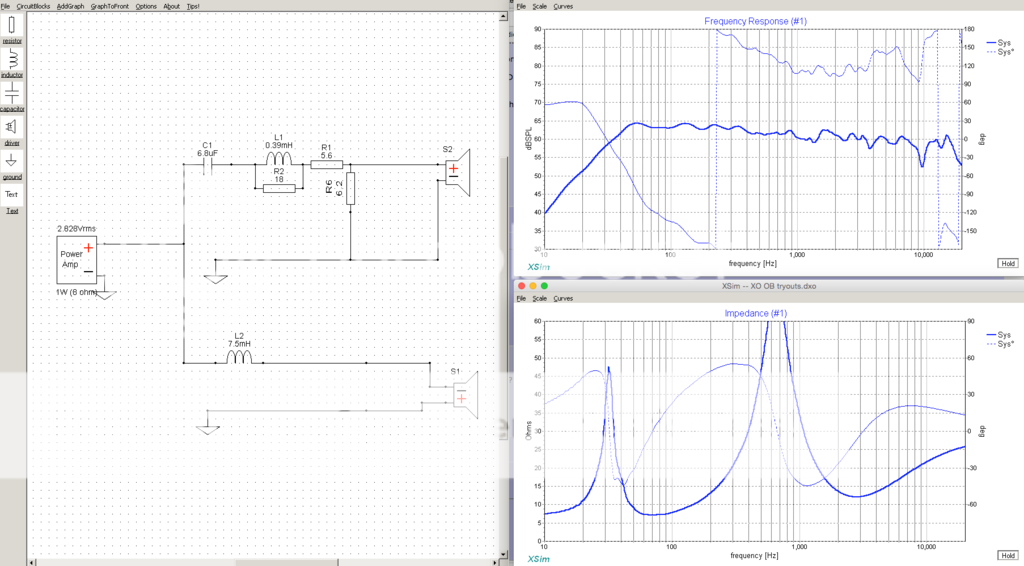
Help a guy out and tell me if I'm doing alright... or is this way off?
I like the FR, but the impedance is not exactly stable...

It doesn't look too bad, and should sound quite good as is. The impedance looks very typical for the circuit and shouldn't cause your amp any trouble with it's 8-ohm nominal load.
It would help if you could include individual speaker FR's with their phase in your FR graph, that way we see any potential issues/interactions from break-up on the woofer. We can also see if the phase is a concern at this point too.
It would help if you could include individual speaker FR's with their phase in your FR graph, that way we see any potential issues/interactions from break-up on the woofer. We can also see if the phase is a concern at this point too.
- Home
- Design & Build
- Software Tools
- XSim free crossover designer
